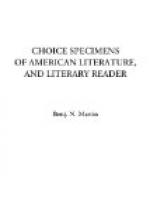Conceive all these shattered walls, with here and there an arched door, or the great arched vacancy of a window; these broken stones and monuments scattered about; these rows of pillars up and down the nave, these arches, through which a giant might have stepped, and not needed to bow his head, unless in reverence to the sanctity of the place,—conceive it all, with such verdure and embroidery of flowers as the gentle, kindly moisture of the English climate procreates on all old things, making them more beautiful than new, conceive it with the grass for sole pavement of the long and spacious aisle, and the sky above for the only roof. The sky, to be sure, is more majestic than the tallest of those arches; and yet these latter, perhaps, make the stronger impression of sublimity, because they translate the sweep of the sky to our finite comprehension. It was a most beautiful, warm, sunny day, and the ruins had all the pictorial advantage of bright light, and deep shadows. I must not forget that birds flew in and out among the recesses, and chirped and warbled, and made themselves at home there. Doubtless, the birds of the present generation are the posterity of those who first settled in the ruins, after the Reformation; and perhaps the old monks of a still earlier day may have watched them building about the abbey, before it was a ruin at all.
* * * * *
From the “American Note Books.”
=_301._= SCENERY OF THE MERRIMAC.




